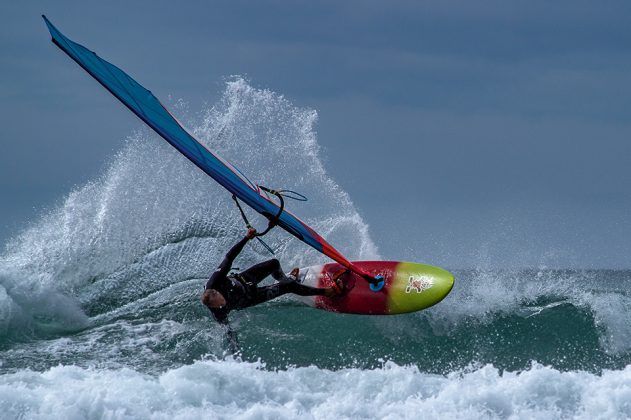“ PETER HART – STYLIN’ ”
Words Peter Hart // Photos John Michelin, John Carter, PWA, Mira Strashilova, Tufty, Billy Mullen.
Originally published within the January February ’18 edition.
Do you have a style? Do you want one … or a better one? Do you care? It’s a bit abstract but Peter Hart, abetted by some names you may well recognize, contends that by focusing on a waveriding style, you can improve both technique and the overall experience.
Before we go any further let me draw the distinction between ‘having a style’ and being ‘stylish.’ What defines the stylish sportsman is a sense of effortlessness. It’s the apparent ease with which they execute a complex skill that draws the eye and makes them such a pleasure to watch. It’s Roger Federer casually dispatching the rocketing service of a giant Russian with the deftest of touches. It’s Usain Bolt breaking 10 seconds for 100m with a cheeky smile and at what appears like a canter. Even in the most explosive, dynamic phase of a move, they seem to have an extra yard of space, an extra second and it never looks as if they’re trying too hard. We can all surely strive to become more stylish on the water but to a large extent, stylishness is a blessed innate gift. You’ve either got it or you haven’t. But as for ‘having a style’ – that’s unavoidable. According to the dictionary, a ‘style’ is just ‘a manner of doing something’ – and we’ve all got one of those whether we like it or not. Happily it is a thing we can change and develop. And no field is more open to interpretation than that of waveriding. The problem for many amateur waveriders is that they have stumbled on that adage of “practice doesn’t make perfect, it makes permanent.” Most tend to frequent the same spot, which works in a certain wind direction. Soon they find themselves following set routines; drawing the same well-worn lines on the same parts of the wave and quickly the spark disappears from the marriage. The route away from the dreaded plateau is to change your style. How? There are so many things you can do – swap kit, tweak setup, change tempo, alter the very technique of turning etc. and we will look at them all. We also have chats with selected stars to see how and why they have developed their styles. So let’s start by identifying waveriding styles and the eccentric adjectives used to describe them.
Powerful
It describes fast, deep, full-rail bottom and top turns at speed with big extended rig movements. It’s best suited to long, fast waves. Think Josh Angulo and Robby Naish. Naish was/still is famous for combining rig and foot power to gouge his turns.
Slashy/slidey/snappy
The sailor turns more off the back of the board, snapping it round rather than full-rail carving. Watch the good guys at Pozo and there’s barely a second between bottom and top turns – ‘bish bosh!’ Off the top the rider sometimes levels the board off (rather than engage the heel side edge) so all the force is taken by the fins, at which point they release and slide. Well … done on purpose it’s a slide – if not, I’m afraid it’s just a spin-out!
‘Surfy’ style
Using the board more than the rig as a source of power. From a deep position, the rider extends and compresses the legs to pump the rails like a skateboarder. Speed comes from those swift rail to rail transitions and from staying in the critical part of the wave. The rig remains pretty neutral and the riders use relatively small sails. Like the surfer, he or she aims to present the board in such a way that the pitching lip (rather than the rider) redirects it. Understandably such riders started out as, and remain, expert, super fit surfers. Check out the Quatro boys like Keith Taboul.
“ After an early trip to Maui I returned declaring I wanted to sail like Mark Angulo, who was whippy and slashy and
generally exciting on another scale – until someone pointed out that the only way that was going to happen was if I had my skeleton removed.
Be realistic with your expectations.. ”
Front foot/back foot style
The good sailors have both and will swap depending on the speed and shape of the wave, and the design of the board. It’s really describing what part of the rail you use to turn. By turning off the front foot, you engage a full rail, draw out the turn and maintain speed. It’s a common style at places like Ho’okipa, Punta Preta, Margaret River and anywhere the waves are big and fast and you need to stay ahead of a charging section. Good front foot turning boards tend to have a lot of curve in the outline.
By turning more off the back foot, you engage just the back third and do more of a carve pivot (see ‘slashy’ style above) that works well on slow, wind blown waves and especially when the wind is onshore. Boards with more width and volume under the tail, of which there are now many (e.g. the Stubby designs), favour a back foot style. As I’ve said in wave and gybing articles before, using the back foot does not mean leaning back. It’s body forward and pressure back.
Vertical Style
Turning as far as you can. Bottom and top turns are at least 180°. The bottom turn comes so far round that the board is heading vertically back up the wave – even beyond vertical; and the top turn comes all the way round to face straight back down the wave or even back upwind. It was a style really pioneered by Jason Polakow in the early 90s and demands extreme separation and flexibility around the hips. Changing fin setup has strong influence on your ability to get vertical.
Tricky/‘freestyley’ style
I’m not sure that’s a recognized title (well it is now) but it’s the art adopted by most of the top riders of integrating aerial tricks within wave-riding moves. It’s not about trying to throw in a cheeky Spock on the flat water between the waves (although … why not?) but of actually using the slope or the pitching lip to redirect the board and complete the trick. At the top end we think of aerial stunts like ‘takas,’ ‘goitas,’ etc but it can also involve more achievable ‘on the water’ stuff like one handed top turns; carving onto the wave face and riding the wave backwinded; or an upwind 360 in front of the wave timed so that the wave whips the nose round.
Fluid
Hard to quantify and is really back into the realms of just being stylish. You think of the sailors’ favourites like Levi Siver and Cisco Goya for whom the whole ride is like a choreographed dance, one move linking seamlessly into the next with fully extended, on the edge, almost balletic body positions and angles.
Staying true to your roots
It’s good to be inspired by new trends and talented performers … while at the same time keeping a grip on reality and your own history.
If you’re a 95kg dedicated speedster experimenting with waveriding and decide to copy the style and setup of flippy, tricky 60 kg Thomas Traversa, you’re in danger of entering ‘elephant wearing tutu’ territory.
If you like speed, and are good at it, then make it a part of your wavesailing.
If fizzing across the water on the edge frightens the beejezus out of you, but you’ve always liked spinning the board round, then take that setup and
attitude into the waves. But understand that both of the above could borrow
a bit from each other’s game. In general most improving riders express a desire to look more dynamic and throw more spray. So let’s start there.
Manoeuvrability – it’s mostly about you!
In search of a new style the first port of call is traditionally the shop. It’s a good move. A different design of board and rig delivers new sensations and encourages you to change. Just the look of the new combo injects gunpowder into your joints and wills you to try harder.
But it could also be that it’s not so much the kit that is lacklustre – but you. So before you turn the old stuff into garden furniture, here are some lines of action that can make a huge difference … without bending the plastic.
Lower the Boom
Freeriders often come into wave sailing with high booms (shoulder and above) because that’s the way to lift the hips, take the weight off the feet and release the board. But the higher you have your boom, the less you can move the rig in the windward leeward plane. The lower the boom, the easier it is to drop it into the turn and depower it.
If the rig stays too upright as you bear away (especially in side off winds when the wind increases as you take off on the wave) that’s when you get over-powered and are forced to drop into the back seat.
To encourage a compact surfing stance and allow maximum rig control, some of the specialists drop it to chest high and below. To most that will immediately feel awful and won’t suit many sailing situations. However, easing it down gradually will allow you more mobility and force you to …
Bend the knees!
On a Tiree clinic just before the 2007 World Cup, Kauli Seadi and Marcilio Browne joined my group for a dawn session at the ‘Maze.’ It’s ever so revealing watching pros and good amateurs sail the same conditions. During the video playback that night I asked people to describe what set them apart. ‘Faster and more active’ for sure – but more specifically it was how much more they bent their knees and used leg drive to carve and steer.
‘Bend the knees’ – it’s a bit of a cliché but try it – I mean really bend them. A lot of people carve just by leaning over, which doesn’t create a dynamic change of direction. It’s when you actively straighten the legs and drive the rail (and then retract them) that you feel what your board is capable of.
Shorten the rail
If you’re apt to trip rails and feel the board is slow to move from edge to edge, it may be you just have a stiff setup. You can effectively shorten the rail by bringing the mast foot and the footstrap back; at the same time moving the fin(s) forward and swapping the centre fin for a smaller, softer one. And do just the opposite (lengthen the rail) if the board is too squirrely and you want a more drawn out, carving style.
Less rig power – change the way you carve.
When learning to bottom turn (downwind) a common instruction is “do half a gybe.” It’s reasonable advice assuming you have a half decent gybe. But ultimately you should regard a bottom turn as a move apart. The biggest difference is how you use the rig. The dynamism of a wave-ride, especially in slow waves, is determined by how quickly you make the transition between top and bottom turns.
In the bottom turn, one approach can be to sheet in less (leave the sail more open). Doesn’t that release the mast foot pressure and make you bounce? Not if you physically project forward and pull down on the boom with your front hand.
With the sail more open, the clew rises above the lip and you’re ready to crack straight into the top turn. If you always sheet in hard, as per gybing, you often find yourself oversheeted at the top of the wave with the clew sticking in the face. The habit of sheeting in hard (or oversheeting) also comes from taking out too much sail (read on), which in turn can bury the rail too deep and stiffen the board. It’s the first step to developing a more surfy style where you generate speed by driving the rails rather than powering up the rig.
Tempo Change
Many times gold medallist Matthew Pinsent once said of rowing: “it’s as much about relaxation as it is about tension.” Which seems strange for a power/endurance sport. It’s the same with wave sailing.
Sorry to pick on the speedster again, but often their ride on the wave is a charge – they pick it up and ‘hoon’ along the face until they run out of wave or hit the shingle – same speed, same power, same radius arcs, same tempo.
In comparison, the style-master floats, gouges, speeds up, slows down, stops, accelerates etc. With regard to tempo, consider these points:
• Sheet out! Some windsurfers regard sheeting out as a sign of weakness. In wave riding you depower as frequently as you power up. What makes a top or bottom turn spectacular is going from no power to full power. Watch all the good guys just before a gouging change of direction, and they will be sheeted out. And then “wham!” They suddenly power up the sail and direct that power into rail.
• Release Pumping, jumping and waveriding – it’s all about releasing the board. A good top turn is about letting the wave redirect the board down the face. It can’t do that if you’re sheeted in and driving the nose into the lip. It’s by depowering the sail that you release the mastfoot pressure and allow the wave to do its work.
• Stopwatch! I’ve mentioned before that a good way to improve tacks and gybes is to put a stopwatch on them. The faster you get from powered up on one tack to powered up on the other, the less time you have to mess up and the faster the exit. It’s the same with riding. Look at the riders who turn heads and even on a Jaws-esque wave there’ll be less than 2 seconds between top and bottom turns. You wipe off the seconds by going faster and carving harder and tighter.
Try Harder
And lastly in the human section, it’s simply about going for it. The ‘powerful’ or ‘vertical’ styles are only won by putting your board, rig and body at angles beyond what you’re used to. Keep pushing it, making tighter and tighter initiations until the rail trips or the fins let go. It’s exhausting mentally and physically – but it’s ok to have a ‘tiring’ style. But to accomplish all that, you may ultimately have to change the tools.
The right amount of change
The problem with a traditional, long single fin board is that you can sail and turn it like a freeride board – that is to say hooked into short lines, straps tight, feet wrapped around the rails and back foot driving against the fin. It’s not a good waveriding stance but you can get away with it.
If you move to a contemporary multi-fin design, you’re forced to change. Small fins won’t accept back-footed, lateral abuse. You have to stand taller, ride with feet inboard and favour the front foot. You can only do that by lengthening the lines.
And in the turns, if you hoof the back foot, you’ll spin out and stop.
Instead, you use the mastfoot and front foot as a platform to lay the rail and then control the radius of the turn by moving between front and back foot.
On older style single fins you could get away with pivoting around the tail.
On shorter modern designs you have to turn around the rail.
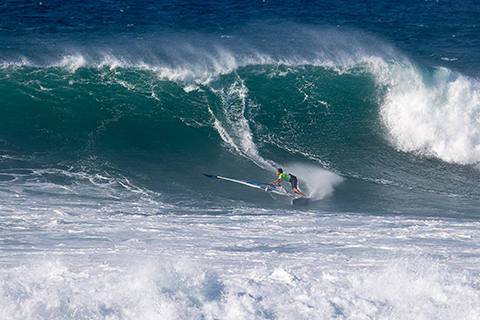
The style that impresses even the best – Levi Siver in full glorious, full rail, classic bottom turn. PHOTO JC / PWA
Changing board is not enough to turn you into a modern slasher. You have to change the setup, your stance, your relationship with the rig and the way you use the power in the turn.
“I’m not sure I want to!”, I hear you cry. Well you don’t have to. You can move towards a new style in baby steps.
‘Softly softly catchy monkey.’
I have taught many speedy freeriders to sail waves. For them the sensible weapon is a fast freestyle wave board with a single fin setup. Dedicated multi-fin wave boards ride nose down and sit deeper in the water, which makes them less likely to fly out of control but it’s not a feel beloved of speedy types. They are fast but don’t feel it – so the fsw is a good compromise.
They start with that familiar sensation of the board lifting on the fin, releasing and gliding on a tiny area. They then lengthen the lines inch by inch, which allows them more freedom in the harness to hold the rig and themselves forward. They open the front straps and as they move forward, they can reduce fin size, perhaps add thrusters if there’s the option – but all the time they have that familiar security blanket of something solid under the back foot.
But as with all things windsurfing, it’s all about the power.
“ The aspiring wave sailing leopard can change a few spots – but not all of them.”
BACK TO HOLEY CHEESES
The ways a good day turns into a dangerous one are when:
You run out of skill – you launch into conditions you can’t handle or select a board and rig combo that’s too challenging.
You run out of kit – something breaks.
You run out of coping strategies – no plan of how to self-rescue – never practiced.
You run out of strength – unfit, no stamina. Fatigue prevents waterstarting, uphauling, balancing and leads to bad, panicky decisions.
You run out of weather (or get too much) – an unforeseen change in wind and sea state changes the whole scenario.
You run out of company – you’re out there alone.
You run out of shoreline – you’re too far out.
You run out of health – you get injured.
One of the above happening may not be too bad. But when one or two or three coincide and the holes start to line up, that’s when dark clouds gather. Certain combinations quickly produce a perfect storm.
Unfit bloke sailing way offshore. Bad. Unfit bloke sailing offshore crashes and breaks UJ. Worse. Unfit bloke sailing alone offshore, crashes and breaks UJ. Very serious. And if the unfit, alone bloke is injured and the board separates from the rig and floats off downwind – he’s potentially another Marie Rose.
Sailing alone heads the ‘no no’ list. But close behind them and the ones you have the most control over are sailing way offshore and the fitness question.
INCAPACITATED
If you’re fit, unharmed and appropriately dressed, as Matthew Bryce displayed, you can find a way out of the most extreme situations. It’s when you get injured that suddenly the game changes…
Jim McNaughten
“I was in Jeri in Brazil. It was getting late. Conditions were perfect 5.0 weather so I decided on one last blast out to sea. I gybed on a swell, blew it and when I surfaced knew something was wrong. I’d dislocated my shoulder. It was so painful there was no way I could waterstart. In fact all I could do was lie in the water because that was the only comfortable position. I didn’t realize how far out I was – way beyond all the other sailors. Luckily an instructor had seen me. He told me not to move and stay with the kit and he’d get the boat. Because we were so far downwind by this stage, it took ages for him to get back. And by the time the rescue boat came it was getting murky and they took a while to find me – bloody scary. Heavens knows why, irrational panic I guess, but I was even contemplating abandoning the kit and swimming for it. I’m a good swimmer but no one can swim with a dislocated shoulder. I guess you don’t realize when you’re fully planing in a sideshore wind, how much ground you cover. The lesson I got was never to be the furthest one out.”
I’ve encountered a few injuries out to sea. With lower limb injuries, I’ve recovered the victim’s rig and got them in the waterstart position from where they can drag in. But the worst have been dislocated shoulders because the victims can do virtually nothing. They’re pretty rare. I’ve only encountered 2 and the way we got one in was four of us to cradle him in his rig. Luckily he wasn’t alone and not too far offshore. It’s at those rare moments when buoyancy is a lifesaver…
“ The wind doesn’t necessarily get stronger the further you sail out. And if you get injured, the closer you are to shore,
the happier you’ll feel.”
ADAM LEWIS
Fresh from his victory in Tiree and having made the top five in the PWA rankings, Adam is officially world class. Is he aware of having a style?
AL – I think one of the awesome things about windsurfing is you kinda have your own style whether you know it or not, so I definitely think you can develop it but I don’t think you can change it. If you do you’re almost fighting yourself. I guess my style has come from just doing what I like to do… I still like to bottom turn as hard as I can and see what happens.
PH – Are you aware of changing style as you’ve changed board and sail designs?
AL – I think board and sail design can influence style massively. I really found when I was testing for the magazines, some gear would force you to change your approach to a wave ride or a move, so you learnt a lot of things you wouldn’t have learnt on your own gear.
PH – Have you had any proper light bulb moments with new kit or setups?
AL – Yes … it was about fins. I’d used a few thrusters before but not really thought much of them. I preferred quads. Then one of the guys on the beach literally forced me to take a certain thruster set. Massive lightbulb moment for me, I could go wherever I wanted on the wave. It really surprised me and I haven’t looked back.
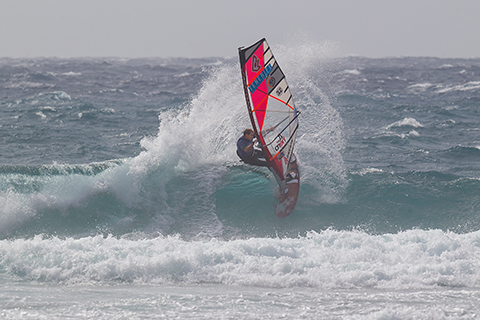
Adam going where he wants at Medano on his thruster set up. PHOTO JC / PWA
COLIN ‘WHIPPY’ DIXON
“ I try my hardest to have a style – trying to be a bit more slashy off the top and throw buckets of spray – I learned it off the Frans brothers. Watching Tonky sail he really throws his head. It makes such a difference. It weights 5kg, so everything else follows. It helped when I had longer hair! I started in the 90s. Dunkerbeck was the solid terminator but Polakow brought style into wavesailing along with Cisco Goya. Kit has changed me. When I got handed a custom twinser in Oz my style changed immediately. Having fins on the side helped me get more vertical for sure. I like the stubby designs but you’ve got so much volume under the foot that I get a bit lazy with them. I prefer a board with a thinner tail because you have to be more active.”
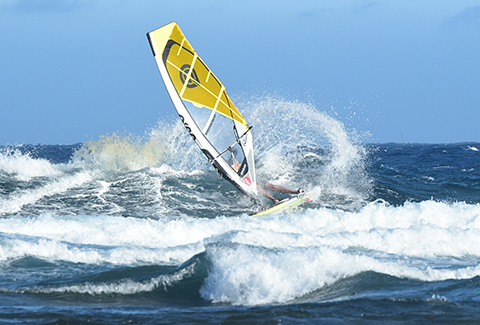
‘Whippy’ whipping. PHOTO Mira Strashilova
TIMO THOUGHTS
Timo Mullen has put more hours into his wavesailing than anyone on the planet and has developed into one of our most consistent and stylish performers.
TM – My idols for style have always been Scotty McKercher and Francisco Goya, Francisco for his bottom turn and Scotty for his full rail gouging cutbacks. I’m in no way saying I mimic either of these two but that is what I aspire to; aiming for a top to bottom down the line style that I think we all would love to have. Recently I changed board sponsor to Severne and am using the Nano with a stubby outline, which has really forced a style change. I found with the Nano I was using the rail so much more in my bottom turn; but on my cutback I was turning more off the rear section of the board allowing more spray and greater fin release on vertical sections – a total opposite in styles to a more front footed attack on my older boards. Both styles work fine but what I’d say the advantage I have now is that I can attack the lip with more speed and hopefully have a more radical approach to the lip in onshore, a style that Jaeger Stone has made his own.
PH – Do you find your style changing in proper side off conditions?
TM – In quality cross/cross offshore waves I’d say my style would completely change from my onshore style, reverting to a more traditional style particularly when the waves get bigger and/or faster. I’m working with Severne and Scotty McKercher on a new Quad shape that is still fast like the Nano but has a slightly more traditional drawn out profile with a slight hip in the tail section, this has been working really well when the waveriding conditions are exceptional, where laying rail and surfing the wave and harnessing the raw energy of the wave are more important than trying to generate speed and flow in onshore waves.
PH – You’re noted these days for using exceptionally small sails, despite your size – ripped of course!
TM – In the last 2 years I’d say I am using the smallest sails out of anyone on the beach. Yes I have dropped a lot of weight from 92kg down to 84kg but more so I have found that efficiency in your rig is the key to improved performance. In Gnaraloo, guys 10kg lighter than me were not planing on 5.7’s and I was flying on a 5.0 blade.
PH – Are you bagging the small sails out?
TM I set the sail relatively flat, well I say flat but I think that I rig the same for full power as I do for underpowered. It basically goes back to that efficiency talk, the sail is built to be efficient all the time as long as it is rigged correctly – a light and efficient sail will transfer the energy of the wind way more effectively than possibly a larger more surface area sail rigged badly.
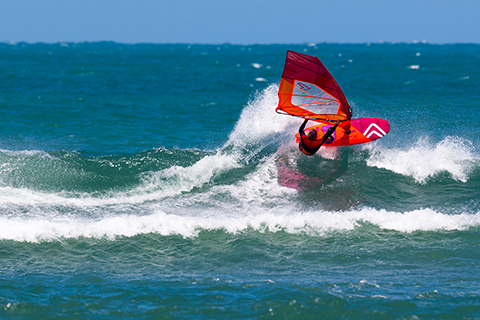
Timo cranking off the lip on his new Severne Nano. PHOTO JC
RU SOMMERVILLE
Recently crowned youth champion at the Tiree wave classic, Ru, at just 14 is the real deal. Faced with so many influences, is style a consideration?
“I’ve been sailing in waves since I was nine but did my first passable bottom turn at 13. It was sloppy. I leaned back and my front hand (which I was convinced was in the same position as Levi Siver’s at Ho’okipa) was touching my chin. In the years since then my frontside rides have gotten a lot better. I sail a lot in cross-onshore and, perverse as I am, I would easily take a windy, cross-on head high wave to a perfect peeling DTL wave any day of the week. (I still would give my left nut to go to Ho’okipa, though!) There’s something about how dynamic and fast you need to be to get good turns off a messy onshore wave. It’s much more enjoyable to me than carving up and down a clean smooth face.
My style is derived a lot from watching videos of the younger riders on the PWA tour. Koster and Moritz Mauch especially have this slashy, quick style that really appeals to me. The two boards I use the most are my 87l Starboard Black Box and my 60l Pro Kids Flare. The Black Box (short with very thick tail) really suits my style; since I started using it I’ve been doing more and more slide-y laybacks off the lip. As I started using these boards more I noticed my style changing. I guess the keyword for my style would be “slashing”. Short, aggressive turns suit me best! I’ve been working up the courage to start trying some cool moves on the waves, but I haven’t landed my No 1 priority, (a frontside wave 360) quite yet.
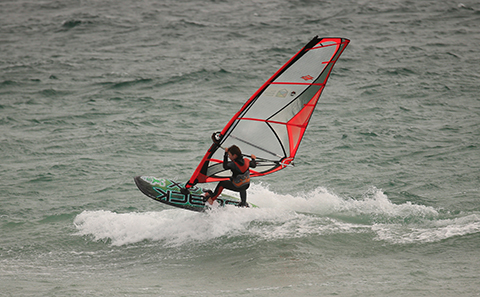
Ru Sommerville slashing off the top on his Black Box. PHOTO Tufty
Change your relationship with the rig – different combo.
If you’re a wind driven windsurfer turned wave sailor who relies on sail power and likes to rig big, you have no option but to resist that power, which of course limits your mobility. You can’t project forward and back and take up steep angles because you know the rig will pull you off balance.
As you watch the good guys sail in any one of the styles I described at the beginning of this article, the one thing they will have in common is that compared to a decade ago, they’ll be using a sail at least 0.5 sq m less and a board of 10 ltrs more. Early planing and speed come from the increased board volume leaving them with a sail that pulls less and which is easier to hide and depower. Changing to a small sail/big board combo is the very best way to promote a more mobile, dynamic style.
A CHAT WITH FINN
Spending a lot of his time surfing gargantuan swells, our editor Finn Mullen brings something very pure to his waveriding. And he has a few things to say about style.
FM “ “Is style nature or nurture? A bit of both I’d say – there’s enough evidence to suggest that growing up in Gran Canaria you’ll be a jumping wizard and with Maui as a base you’ll be an expert waverider. But one of the factors influencing our style that we have the greatest control over is our gear. Just like our sister sport of surfing, equipment plays a big part in the lines we take on a wave. It’s not a bad thing. Pro surfers have a ridiculous number of boards in their quiver because that all-important style becomes stale if you don’t mix it up every now and again. And variety in style breeds performance. When I switch between 4 and 5 batten, high and low clew sails, thrusters, quads, singles or twins, I’m forcing my body to adapt to all the subtle differences between the equipment and learning new lines and approaches to the wave face. Your sailing becomes more versatile and a change in equipment can often help break a rut; stiff on one particular tack – use a looser fin setup to help your turns and teach some muscle memory on your weak side. Most of all mixing up your equipment keeps sailing fun, don’t fall into the trap of pegging yourself as a one trick pony. Much of the progression in style in windsurfing and surfing has been born from riders continually changing their equipment designs to keep progressing.
Kit is just one part of the mix though and if you’re not blessed with inordinate amounts of talent than there is still a lot to be said for the ‘monkey see, monkey do’ school of style. Video analysis is used by all top sailors or surfers. Watch the pros to learn what you should do and watch videos of yourself to learn what needs improving. But style is of course subjective, who cares really if your style isn’t someone else’s favourite as long as you have fun along the way. The style journey continues as long as the joy doesn’t stop.”
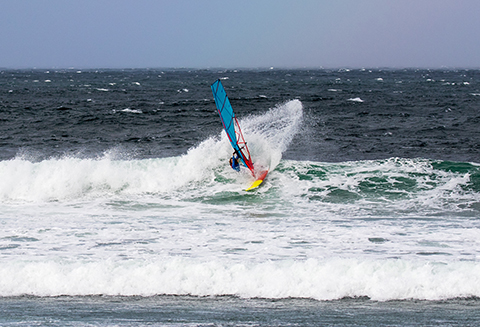
“How much spray would you like sir?” Finn breaking out. PHOTO Billy Mullen.
JOHN SKYE
Strong across all the disciplines, Skyeboy combines experience, skill and design knowledge to produce a class act in the waves.
“As to style. I think the guy I look at the most is Levi. I think he has a great mix of power, speed and also has a stylish trickery to him. Everything he does, whether it be jumping or riding, he always makes it look amazing! It’s hard to comment on your own style, but I think I am powerful and like to go fast. If I am critical I think I am often too upright and a bit stiff, but that is often equipment choice and setup to get the power and speed I want. I think my basic style has hardly changed over the years. The change in equipment, particularly multi-fins, has made it possible to take new lines and maybe stay a bit closer to the wave. However my personal style is generally to have my setup a bit stiff anyway, so that counteracts the changes, and instead of getting looser I use the fin setups for increased grip and drive. With a quad I think I am more over the top of the board and always try to keep everything underneath me. With a thruster I think I push a bit more in general particularly off the top. In general I use a quad in riding conditions and thruster in more onshore. The change to 4 battens a few years ago made a huge difference to my style. The additional reactivity of the sail means that the moment you finish a top turn, you have power in the sail to drive straight into a bottom turn. The older style 5 batten sails need to load up before you can go into the bottom turn, so there is a bit of a pause after the turns.“

Skyeboy reckons he’s a bit stiff – but we know better! PHOTO JC
Summing up with a personal tale.
For me it’s a game of trying to be trendy and a traditionalist at the same time. A lot of the latest designs are all about the top turn. There’s so much volume under the back foot that you can drift up to the top, then hoof it round and make a lot of spray. But probably because I used to do a lot of slalom, I love the feeling of holding an edge at speed. Hence for me it’s all about the bottom turn – laying the whole lot over and looking over the mast tip at the bit of wave I want to hit – and for that I prefer a board with a more drawn out outline. My mantra to clients is ‘do a good bottom turn and the top turn will look after itself.’ It’s the speed you carry back up to the lip that allows you to produce a foam shower. And likewise off the top I prefer to carve a top turn rather than slide it. With a slide I never know if or when the fins will break out and if I’ll be able to get them back. The thruster setup with a softer centre fin seems to work perfectly for me. And with the general setup I absolutely embrace the big board / small rig option – but not too small. Having spent a great chunk of my career over-powered, I prefer a little too much to a little too little; which I balance by going slightly longer with the fin. Which means the aerial, fully inverted tricks are harder – but now that I’m in my late 20s, they’re a distant dream anyway!
Let’s conclude with a little perspective – in waves there are no set patterns, things you have to do, no lines you have to follow. All that counts is that is that you’re out revelling in the sensations and not being pushed into trendy corners that don’t fill you with joy.
The technique journey continues with Harty in the next issue. Check out www.peter-hart.com for news on remaining clinic places for 2018.



